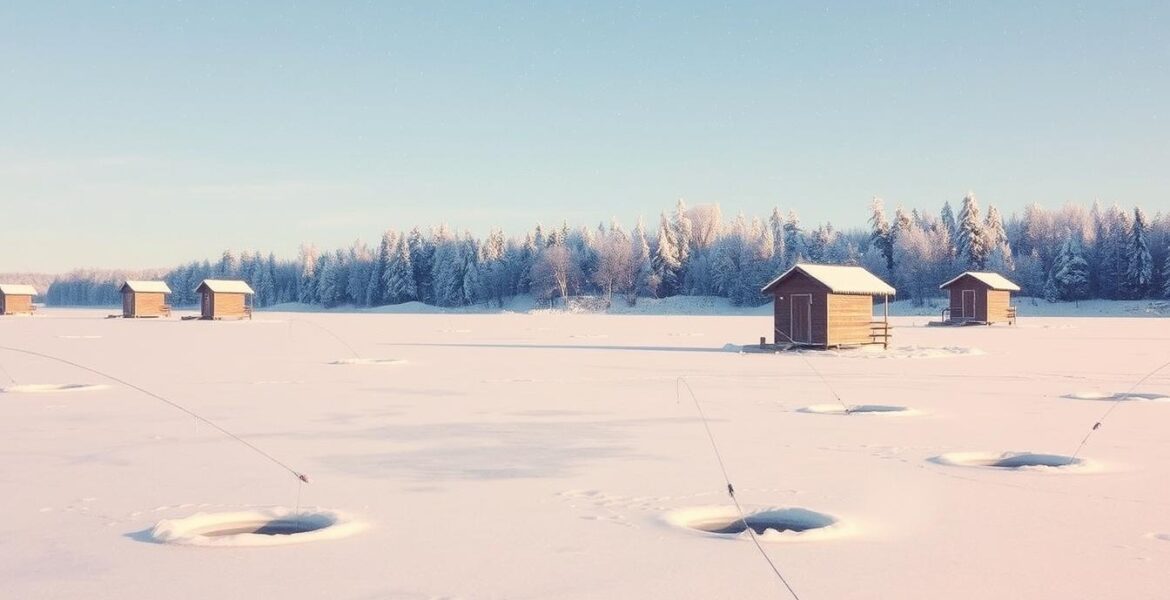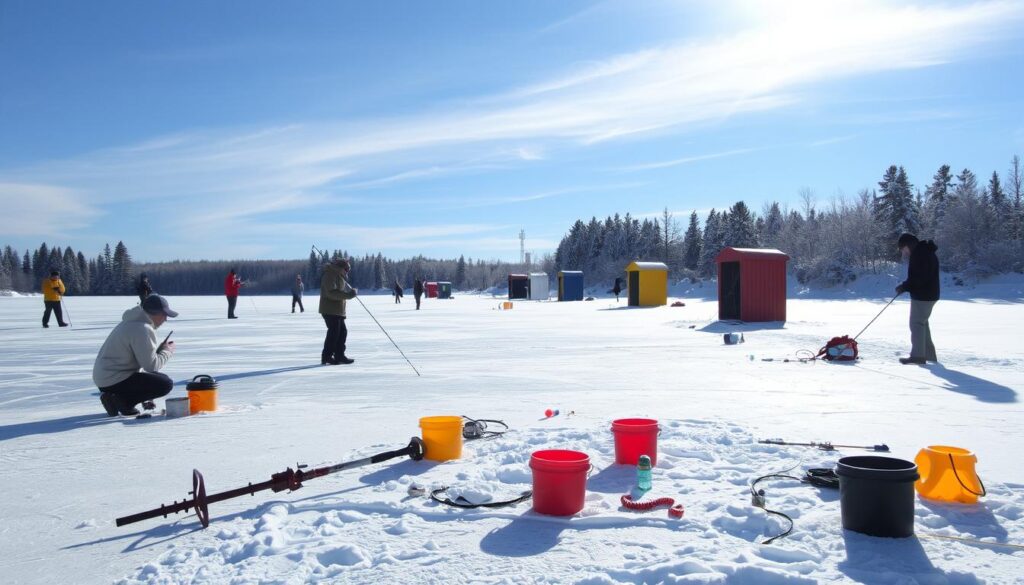
Essential Tips for Winter Ice Fishing Success
On December 11, 2024 by fishingamericatodayDid you know Ice Castle’s Arctic Insulation Package is made for Minnesota’s cold winters? As it gets colder, many people go to the state’s lakes for ice fishing. They’re looking for walleye, northern pike, crappies, and bluegills.
Minnesota’s ice fishing season can last months. This makes both old and new anglers excited for winter. Many people in Minnesota love ice fishing, and Ice Castle Fish Houses are very popular.
As it gets colder, people want special gear more. This leads to a big increase in sales. But, it’s also important to stay safe and organized while ice fishing.
These tips are for both new and experienced ice fishers. They’ll help you enjoy your time on Minnesota’s lakes. Learn about lures, jigging, and setting up your shelter. Now, get your gear ready and catch the big one!
Getting Started with Ice Fishing Safety and Equipment
Ice fishing is fun in winter, but safety comes first. Know the safety gear and ice thickness rules before you go.
Essential Safety Gear and Ice Thickness Guidelines
For safe ice fishing, aim for 4 inches of clear black ice. Check the ice thickness as you move from shore. Always wear a life preserver when checking.
Carry a long rope and ice picks. They help if you fall through.
Basic Equipment for Beginners
Beginners need an ice chisel, a hand auger, and a hole skimmer. These tools help make and keep fishing holes.
As you get better, think about a power auger. It drills holes fast, with gas or battery power.
Choosing the Right Ice Auger
The right ice auger depends on how often you fish. Power augers like the StrikeMaster Lithium 24V are great for regulars. They drill holes fast.
Always put safety first in ice fishing. Follow these tips and use the right gear for a fun and safe time.
Winter Ice Fishing Locations and Timing
As winter gets colder, ice fishing fans can’t wait to go. They head to frozen lakes and rivers. The best spots are 3-20 feet deep, with rocks, weeds, or sharp edges.
Early ice fishing is great because fish are hungry. They’re more likely to bite.
The best time for ice fishing is late December to early March. During this time, the ice is thick enough. People fish for walleye, trout, and perch. These fish are tasty and hard to catch.
Places like Lake Inari in Finland and Lake Baikal in Russia are famous for ice fishing. They offer unique experiences.
In the U.S., Silver Lake in California and Brainerd Lakes in Minnesota are great spots. Devils Lake in North Dakota is also popular. These places have different fish and beautiful views.
But, ice fishing can be dangerous. It’s important to stay safe. This means wearing the right gear and being ready for emergencies.
Some top ice fishing spots in the U.S. are:
- Lake of the Woods in Minnesota and Canada. It’s huge, with 1,700 square miles of water. The season starts in early December and ends in late March.
- Chambers Lake in Colorado. It’s 255 acres big and sits at 10,000 feet. You can fish for trout here.
- Devils Lake in North Dakota. It’s 180,000 acres and has solid ice from mid-December to late March. You can catch big perch, walleyes, and pike.
- Saginaw Bay in Michigan. It’s a big part of Lake Huron, covering 1,143 square miles. You can fish for walleye, perch, whitefish, and trout here from late December to mid-to-late March.
When picking where to ice fish, think about how many others are there. On busy lakes, fish go deeper fast. But on quiet lakes, they stay shallower longer. Look for green spots in the water, about 10 feet deep, for early-ice fishing.

Effective Techniques and Bait Selection
As winter ice fishing season starts, it’s key to use the right methods and bait. Early winter is great for trout fishing because there’s little to no fishing pressure. Using advanced ice fishing tactics can help catch more fish.
Live Bait vs Artificial Lures
Ice fishermen can choose between live bait and artificial lures. Live bait like minnows and waxworms can attract picky fish. Artificial lures, like the Lindy Quiver Spoon, can also work well by mimicking baitfish.
Jigging Techniques and Strategies
Learning jigging techniques is vital for ice fishing success. Tools like the Custom Jigs and Spins Ratfinkee are good for jigging. Keep the bait 6 to 10 inches off the bottom for better chances of catching fish.
Using a deadstick rod next to your main rod can help catch light-biting fish. A sensitive rod tip is important for feeling small bites.
Setting Up Tip-Ups Properly
Setting up tip-ups correctly is another important ice fishing technique. Tip-ups suspend bait just off the bottom, targeting fish in shallower areas. Check the traps every half hour to keep baits fresh and lively.

Setting Up Your Ice Fishing Shelter and Comfort
Staying warm and comfy is key for a great ice fishing trip. Wear warm clothes, more than you would for other winter fun. Choose breathable, moisture-wicking layers that you can adjust as needed.
Don’t forget your feet! Insulated boots will keep them warm and dry on the ice.
An ice fishing shelter keeps you safe from wind and cold. Think about adding a portable propane heater for extra warmth. You might also want a small grill, folding chairs, and something to listen to or play.
- Make sure your ice fishing shelter is well-insulated to keep warm
- Use a synthetic sleeping bag and insulating mats to stay cozy
- Bring a power bank and solar panel to keep your electronics charged
- Organize your shelter into different areas for different activities
By getting your ice fishing shelter and winter fishing comfort ready, you can focus on fishing and enjoying the winter view. Remember to pack the right ice fishing clothing to stay warm and dry.
Conclusion
Ice fishing is a fun winter activity for everyone. It’s great for both newbies and experienced anglers. I’ve given you tips on safety, gear, and how to catch fish.
Ice fishing wheelhouses add a lot to your experience. They make camping in the cold much better. These shelters have special features like climate control and can move easily.
The best part of ice fishing is the fun with friends and family. It’s about catching fish and enjoying the quiet winter. Follow the advice in this article for a great time ice fishing. So, get ready, pack your gear, and start your ice fishing journey!
FAQ
What are the key early-ice areas for winter ice fishing?
Early-ice spots are shallow. They include points and areas where the water first meets the shore. Shallow weeds also count.
Many minnows spawn in these areas in fall. They stay there early winter. This makes them a great food source for fish.
What is the recommended minimum ice thickness for safe ice fishing?
You need at least 4 inches of clear black ice to fish safely. Always check the ice thickness as you move away from shore.
Wear a life preserver when checking ice. Stay away from areas near inlets or trees.
What basic equipment do I need for beginner ice fishing?
Beginners need an ice chisel or spud, a hand auger, and a hole skimmer. Power augers are good for those who fish a lot.
What are some effective early-ice fishing techniques and bait options?
Early ice is best with natural presentations. Try the Lindy Quiver Spoon. For panfish, use Lindy Tungsten Toads with spikes.
Experiment with different lures and baits. Use smaller baits. Be ready to change your tactics based on the fish.
What clothing and comfort items should I bring for a successful ice fishing trip?
Wear warm, breathable, moisture-wicking layers. Don’t forget good footwear. An ice fishing shelter and a portable propane heater can make your trip better.
Bring folding chairs and things to do. This will make your time on the ice more enjoyable.
Archives
Calendar
| S | M | T | W | T | F | S |
|---|---|---|---|---|---|---|
| 1 | 2 | |||||
| 3 | 4 | 5 | 6 | 7 | 8 | 9 |
| 10 | 11 | 12 | 13 | 14 | 15 | 16 |
| 17 | 18 | 19 | 20 | 21 | 22 | 23 |
| 24 | 25 | 26 | 27 | 28 | 29 | 30 |
| 31 | ||||||
